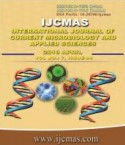


 National Academy of Agricultural Sciences (NAAS)
National Academy of Agricultural Sciences (NAAS)

|
PRINT ISSN : 2319-7692
Online ISSN : 2319-7706 Issues : 12 per year Publisher : Excellent Publishers Email : editorijcmas@gmail.com / submit@ijcmas.com Editor-in-chief: Dr.M.Prakash Index Copernicus ICV 2018: 95.39 NAAS RATING 2020: 5.38 |
Integration of farmers preference, bio-physical, socio-economic resources with scientific evaluation is important for viable land use planning to conserve and use available resources in a sustainable manner. In many countries, participatory approach has proven to be essential in successful planning and implementation of land use plans. The main aim of this study to enhance the rural livelihoods through participatory land use planning approach. This paper reports Participatory Land Use Planning (PLUP) methodology developed by integration of farmer’s preference through PRA, bio-physical evaluation of soils by land evaluation and socio-economic resources and tested in Eastern Maharashtra plateau of Central India. The study revealed that land use planning is dependent not only on the soil suitability criteria but also on the market forces, economic situation of the farmer, short term family needs, level of perception, social status, proximity and fragmentation of land and migration (labour). The introduction of such PLUP, which are mutually agreed by stakeholders and researchers improved the adoption of alternate plans and in turn increased the productivity of different crops by 14-48 per cent. Crop selection based on soil suitability, soil and water conservation measures using local resources coupled with application of required inputs were the key ingredients of this approach.
 |
 |
 |
 |
 |